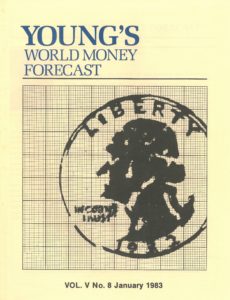
After meeting monthly strategy report deadlines since 1978, I have decided it’s time to switch gears.
The name Intelligence Report will survive, but with no contribution from Richard C. Young.
Instead, I am transitioning aggressively to full-time research on behalf of private clients of our family investment management firm, Richard C. Young & Co. Ltd.
In this expanded venture, I will completely shift away from common stock mutual funds. I will concentrate laser like on “Dividends Around the World” from domestic and foreign common stocks with track records of increasing dividends for at least the last decade.
The Return of Young’s World Money Forecast
Supporting my international intelligence gathering and research efforts will be the return, after nearly a four-decade hiatus, of Young’s World Money Forecast (YWMF). I will be using YWMF techniques, gathered on Wall Street in the late sixties and early seventies, to provide breaking trends years ahead of the crowd. Here I am looking at a mix of inference reading and anecdotal evidence gathering based on my annual over 15,000 domestic miles on the road as well as at least two research forays to Europe each year.
 Although I will not be making my portfolio management and specific dividend stock advice available at youngsworldmoneyforecast.com, I will be presenting regularly updated and customized information on all the dividend-paying stocks I’ve advised on over the years as well as input on every stock in the DOW 30. (Check back here regularly for date of site opening.)
Although I will not be making my portfolio management and specific dividend stock advice available at youngsworldmoneyforecast.com, I will be presenting regularly updated and customized information on all the dividend-paying stocks I’ve advised on over the years as well as input on every stock in the DOW 30. (Check back here regularly for date of site opening.)
A veritable treasure trove of intelligence will be at your fingertips daily—thanks to our unique $30,000/year database. You’ll feel as if you have arrived at a private investment club after all the years you have spent with me and the “monthly printed word.” Among the plethora of improvements you will experience with YWMF online is an enormous timing advantage. You’ll be able to access ongoing regular and actionable dividend stock updates from me in real time, rather than wait for the archaic snail mail. That’s one of the forward looking conclusions I came to when deciding to shut down my monthly deadline and dated in-the-mail effort.
My concentration will continue, as it has been over the decades, on strictly dividend-paying, dividend-increasing stocks. I, however, am making a clean break from the common stock mutual fund universe that I have been deeply involved with since the early sixties. Many of my long-time favorites have become too big for their own good or for that matter anyone else’s. Many funds have failed to keep up on many fronts, including expenses. I abhor the stupidity and self-serving interest of multiple portfolio managers. This dreadful and obfuscating transition has everything to do with dinosaur status and size limitations rather than you the investor. I will continue researching fixed-income and balanced portfolios, where I continue to find great value in individual manager input.
Ben Graham (the all-time dividend maven) was fond of stating: “One of the most persuasive tests of high quality is an uninterrupted record of dividend payments for the last 20 years or more. Indeed the defensive investor might be justified in limiting his purchases to those (stocks) meeting this test.”
The Road Ahead in Real-Time
Well there you have it—my transformation from delayed and printed monthly copy to a rapid-fire, digital presentation (not in audio or books, of course) is now in the exciting kickoff phase.
As my online dividend intelligence program develops steam, I will be able to refine and improve upon my efforts since I am no longer constrained by a once-per-month communication. What was especially frustrating was the obvious, but perhaps not fully recognized, 10-day delay from the time I finished writing Intelligence Report to the time you, as a subscriber, received my finished report.
Today and in the future, any time I have a breaking idea, it will be available for your use immediately at YWMF. That has to have a pretty good sound to you. It sure does to me.
Thank you for your years of loyalty. I have worked diligently for over five decades on behalf of private client investors just like you. It is exciting that we can all transition together to a whole new and powerful world of compounding, (more here on compounding) profiting and sleeping soundly investing in the high-octane power of long term “Dividends Around the World.”
Warm regards,

Richard C. Young
P.S. I wrote in the May 2015 issue of Intelligence Report about Ronald Read, who despite working as a janitor was able to use the power of compounding to amass an $8 million fortune by the time he passed at the age of 92.
Pumping Gas to the Tune of $8 Million
Hard to even comprehend, but this great story, courtesy the WSJ’s Anna Prior, recounts how Ronald Read accumulated an estate valued at almost $8 million. Mr. Read, who passed away at the age of 92, made a modest living pumping gas for many years at a Gulf gas station in Brattleboro, Vermont.
A Five-Inch Stack of Stock Certificates
How did Ronald Read manage to become a multi-millionaire? Mr. Read invested in dividend-paying blue-chip stocks. As Ms. Prior writes, Mr. Read took delivery of the actual stock certificates and “left behind a five-inch-thick stack of stock certificates in a safe-deposit box.” At his passing, Mr. Read owned over 90 stocks and had held his positions often for decades. The companies he owned paid longtime dividends. And when his dividend checks came in the mail, Ronald Read reinvested in additional shares. Apparently Mr. Read was the master of the theory of compound interest. Not surprising, his list of stock holdings included such dividend payers as Johnson & Johnson (NYSE: JNJ), Procter & Gamble (NYSE:PG), J.M. Smucker (NYSE: SJM), and CVS Health (NYSE: CVS), all names I write about for you here. No high flyers for Ronald Read, and certainly no technology names.
Protect, Preserve, Patience, Perspective
Obviously Ronald Read had been a staunch practitioner of my PPPP theme, featuring the basics—Protect, Preserve, Patience, Perspective. This WSJ feature article hit the press at the perfect time for me and you, as I’ll now explain. For the first time since I created my Monster Master List—well over a decade ago—I have given the Master List of common stock names a complete overhaul. I have spent weeks in the process with the goal of giving you not only a roster of dividend payers but also a list where every core company has increased its dividend for a minimum of 10 consecutive years. I have rounded out the core list with a handful of special situation dividend payers.
Originally posted on August 14, 2017.
